11. Haworthia emelyae V.Poelln., Feddes Repert.Spec.Nov. 42:271(1937). Bayer, Natn.Cact.Succ.J 34:28(1979). Bayer :115(1976). Bayer :38(1982). Type: Cape, locality unknown, Mrs E. Ferguson in Long 322. Not preserved. Lectotype (B&M): icon (B): H. blackburniae V.Poelln., Kakteenk. 9:132(1937). Nom. illegit. non Barker 1937. H. correcta V.Poelln., Feddes Repert.Spec.Nov. 43:103(1938). Type: Cape, Calitzdorp, Mrs E. Blackburn in Triebn. 978. Not preserved. Neotype (designated here): CAPE-3321(Ladismith): Rooiberg, E. Vanwyksdorp(-DA), Mrs Schnettler in KG 335/71 (NBG): H. picta idem. 44:133(1938). V.Poelln., Desert.Pl.Life :126(1939). Type: Cape, Moeras River, Mrs S. Blackburn in Triebn. 1062. Not preserved. Neotype (designated here): icon, Fourcade 72 (NBG).
emelyae: for Emely Ferguson.
Rosette to 10cm φ, seldom proliferous. Leaves 15-20, distinctly retused, pointed, barely translucent, with scattered elongate small flecks, with obscure raised tubercles, lined, reddish-brown hued. Inflorescence simple. Flowers 15-20, white.
1982 – H. emelyae is a widely distributed species occurring from Uniondale through the Little Karoo to west of Ladismith. It occurs in a variety of different geological formations and varies accordingly. The plants have very short recurved leaves with convex end areas usually flecked with pinkish markings. The forms east of Oudtshoorn usually have rounded end areas and are scabrid on the upper leaf faces. Westwards the leaves become pointed and smoother. However, there are clear signs of intergradation with H. magnifica in the Muiskraal area of Riversdale. Doubt has been cast on the origin of Mrs Ferguson’s plants but G.G. Smith’s records clearly indicate that they came from Van Wyksdorp and that they were collected there by a Mrs Le Roux. The var. multifolia has up to 60, more slender, suberect leaves; and was compared in the original description with H. serrata. Other forms of H. emelyae where the few leaves are shortly recurved and round‑tipped can similarly be compared with H. magnifica var. atrofusca. The eastern forms with the flatter, rounded leaf tips can be compared to H. bruynsii and H. springbokvlakensis. H. emelyae is generally non‑proliferous.
1999 – The 1982 discussion is fraught with error as two species are actually involved. The scabrid element referred to above has since been excerpted as H. bayeri and it is fairly obvious that there can be no extension to H. bruynsii which belongs in the Hexangulares. The problem is compounded by the fact that von Poellnitz described three species all of which are synonymous, and yet may have cited H. bayeri among these. The integration with H. magnifica was through the var. major which is now transferred to H. emelyae because of the intermediate populations mentioned above which occur just east of, and in the closer vicinity of, Muiskraal.

a. var. emelyae.
The typical variety is rather strongly flecked and the leaves are always retused to horizontal and close to ground level. The neotype cited above is a specimen originating from near Vanwyksdorp and sent by the original collector (Mrs Le Roux) to G.G. Smith.
Distribution: 3321 (Ladismith): 20km W. Ladismith (-BD), NBG144768; Springfontein (-CC), Smith 5787 (NBG); 42km Calitzdorp to Vanwyksdorp (‑DA), Mrs Le Roux in Smith 5437 (NBG); Vanwyksdorp (-DA), Joubert (BOL);Rooiberg, E. Vanwyksdorp (-DA), Mrs Schnettler in KG 335/71 (NBG); SE. Vanwyksdorp (-DC), Bayer in KG257/77 (NBG). 3322 (Oudtshoorn): Mt Hope (-CA), Schnettler in KG582/69 (NBG); Moeras River (-CC), Smith 2447 (NBG); N. Robinson Pass (-CC), Bruyns in KG434/75 (NBG); Zebra (-CD), Smith 2905 (NBG); Erfpacht (-DD), Smith 5808, 6106 (NBG); 3323 (Willowmore): Uniondale to Avontuur (-CA), Smith 2935 (NBG).
Inadequately located: Ladismith, Pillans 858 (BOL); Oudtshoorn, Taylor (BOL).
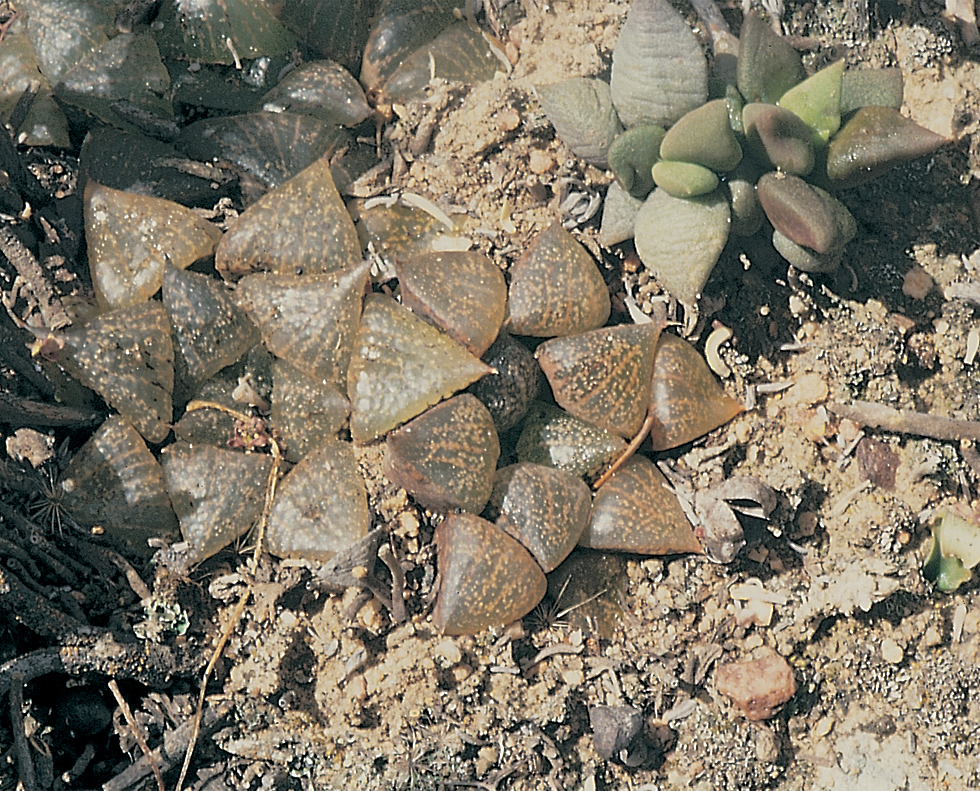
Haworthia emelyae var, emelyae JDV93/28 north of Herold. Attractively marked end-areas make this a sought-after species. 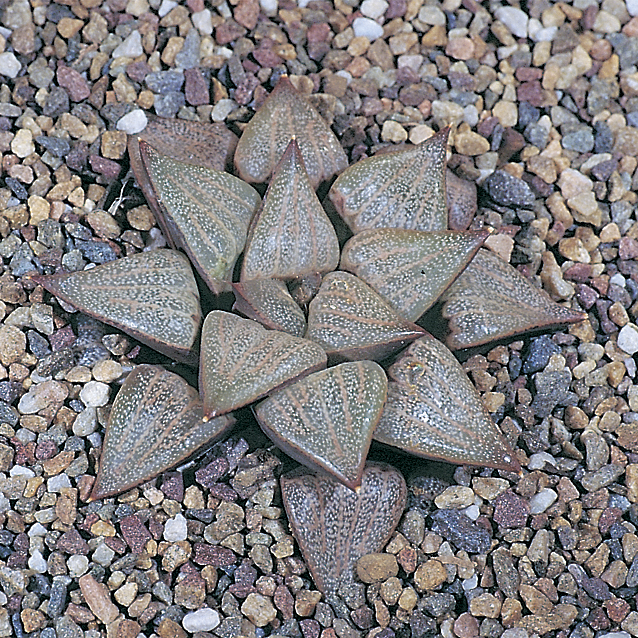
Haworthia emelyae var, emelyae JDV90/120 south-east of Oudtshoorn. Plants in this population are very comparable with the var. comptoniana with much finer reticulation and a smooth leaf surface. 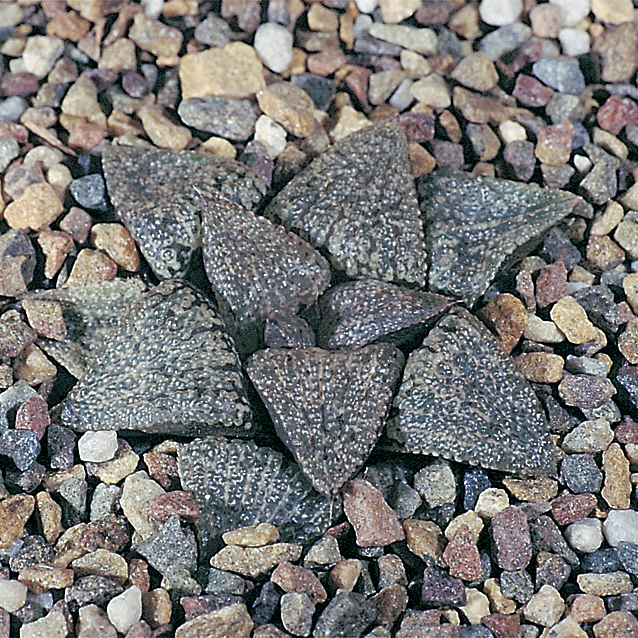
Haworthia emelyae var, emelyae JDV93/22 south-west of Calitzdorp. The plants get more scabrid and have small white markings in the leaves as does, for example, H. turgida. 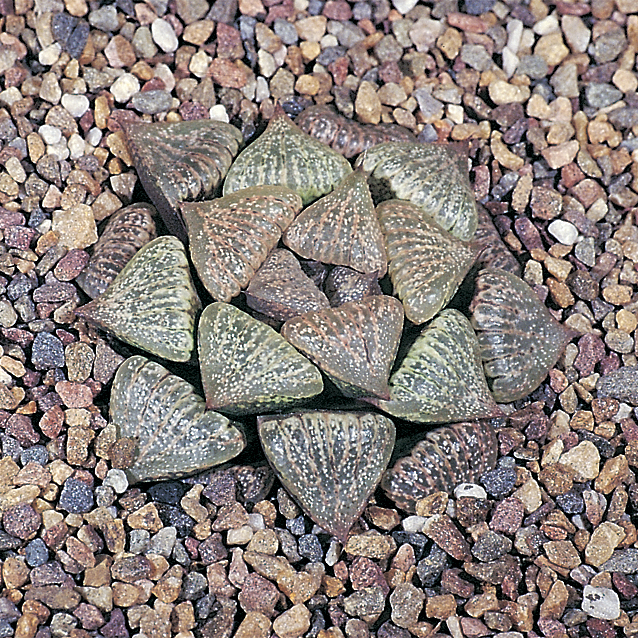
Haworthia emelyae var, emelyae JDV84/11 Zebra, also fairly close to the population of H. bayeri. 
Haworthia emelyae var, emelyae JDV90/10 south of Oudtshoorn. Usually associated with white quartz outcrops. 
Haworthia emelyae var, emelyae JDV93/28 north of Herold. This population has been decimated by road construction and subsequent over collecting. 
Haworthia emelyae var, emelyae JDV90/120 south-east of Oudtshoorn. Fairly glabrous plants which strengthen the link to the var. comptoniana. 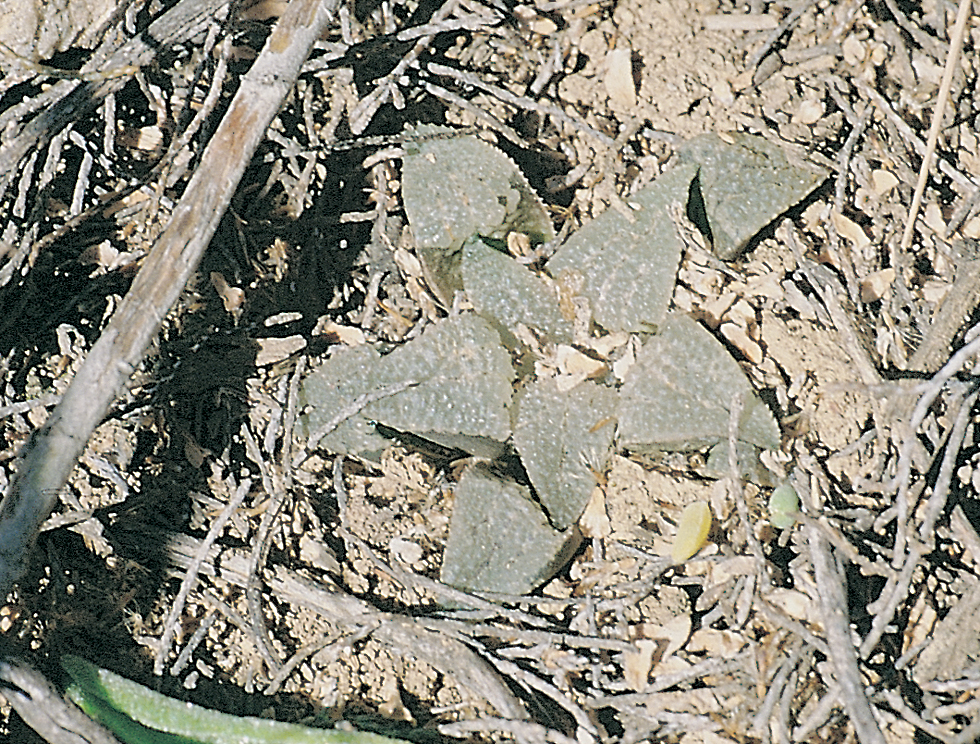
Haworthia emelyae var, emelyae JDV97/133 south of Vanwyksdorp. One of three new collections which seem to confirm continuity with the var. major. 
Haworthia emelyae var, emelyae JDV93/22 south-west of Calitzdorp. Several recent collections seem to confirm the relationship of the varieties.
b. var. comptoniana (Smith) Venter & Hammer
Cact.Succ.J(US) 69:77(1997). H. comptoniana Smith, JS.Afr.Bot. 11:76(1945). Bayer 108(1976). Bayer :33(1982). Scott :128(1985). Type: CAPE-3323 (Willowmore): Georgida (-AD), M. Malherbe in Smith 3433 (NBG).
comptoniana: in honour of Prof.R.H. Compton.
1982 – The species with the flattened ends to the leaves are the most sought after, and H. comptoniana is particularly attractive. It occurs in quartz patches and the plants are often well hidden under the stones. The plants are bigger than in H. emelyae (the nearest relative), growing up to 120 mm in diameter in cultivation. The growth form parallels that of H. emelyae exactly and the difference is that it is a bigger and entirely smooth species. The leaf end area is slightly pellucid and reticulated. Where H. emelyae is generally tinted purplish-brown, H. comptoniana is green. Distribution and abundance is not fully known and H. comptoniana is considered very rare in the field. It has proved very easy in cultivation and good seed is easily produced by cross-pollination.
1999 – This variety grows in very close association with H. bayeri but it is not known if other populations exist other than at the type locality. Some forms which are pale coloured and in which there is little contrast between the reticulation and the background colour and translucence of the leaf, are very plain. Other plants are darker coloured or with more conspicuous specks and marked reticulation, and they are are much more attractive.
Distribution: 3323 (Willowmore): Georgida (-AD), M. Malherbe in Smith 3433 (NBG), Smith 3433 (NBG), Bayer in KG114/72 (NBG).

Haworthia emelyae var. comptoniana JDV90/8 Georgida. Recorded only from one population and severely threatened by collectors. 
Haworthia emelyae var. comptoniana JDV90/8 Georgida. Also very cryptic in the summer months. 
Haworthia emelyae var. comptoniana KG114/72 Georgida. The reticulation and relative length of the leaves are quite variable.
c. var. major (Smith) Bayer comb.nov.
H. schuldtiana var. major Smith, JS.Afr.Bot. 12:1(1946). H. maraisii var. major (Smith) Bayer :132(1976). H. magnifica var. major (Smith) Bayer, Natn.Cact.Succ.J 32:18(1977). Bayer :44(1982). Type: CAPE‑3321 (Ladismith): Garcias Pass (‑CC), Smith 5370 (NBG).
major: greater.
1982 – The var. major has an unusually large flower similar to that of H. emelyae and there is evidence of intergradation of these two taxa.
1999 – Although in this variety the leaf tubercles are armed with a spine, the general form of the plants is that of H. emelyae, and populations east of Muiskraal confirm this relationship. The change in relationship forged here has its roots in the new collections of H. magnifica around Riversdale and in the new arrangement regarding H. maraisii. Another consideration is the position of var. paradoxa, mentioned in 1976, and that is its relationship with H. mirabilis. Similarly the following variety and its position need also to be considered.
Distribution: 3321 (Ladismith): Garcia’s Pass (‑CC), Smith 5370 (NBG), Garcia’s Pass (-CC), Dekenah 9 (PRE); Muiskraal (-CC), Smith 3458 (NBG), Bayer in KG118/71 (NBG); Riversdale (-CC), Muir in NBG164/25 (BOL); Sandvlakte (-CD), Bayer in KG138/72 (NBG).

Haworthia emelyae var. major JDV90/19 Muiskraal. A sandstone-dwelling variety with spines on the leaf surfaces. 
Haworthia emelyae var. major JDV95/36 Muiskraal. The var. multifolia is now know to occur within a few kilometers of the var. major and these two may not vary continuously. 
Haworthia emelyae var. major JDV95/23 Garcia’s Pass. A densely spined seedling grown by P. Bosch and coming from east of the type locality. 
Haworthia emelyae var. major JDV90/22 east of Muiskraal. Several quite variable populations associated with shales.
d. var. multifolia Bayer
Natn.Cact.Succ.J 34:31(1979). Bayer :39(1982). Type: CAPE‑3321(Ladismith): Springfontein, Riversdale (‑CC), Bayer 1558 (NBG).
multifolia: many leaved.
When this variety was described it was associated and compared with H. serrata. A new population is now known a little further to the west and collections by J. Dekenah suggest that it is possibly a little more widely represented in that general area. The plants have many more upright leaves and the relationship with H. serrata through H. heidelbergensis, which is also now better understood, becomes real. There is a strong suggestion that these links all also involve H. mirabilis and this is perhaps supported by von Poellnitz’ interpretation and citations of varieties of that species.
Distribution: 3321 (Ladismith): Springfontein, Riversdale (‑CC), Bayer 1558 (NBG); W. Springfontein (-CC), Smith 5769 (NBG); E. Springfontein (-CC), Smith 5768 (NBG), Smith 5389 (NBG, PRE), Bayer 1558 (NBG); Muiskraal (-CC).

Haworthia emelyae var. multifolia JDV87/162 Springfontein. Since located at two sites east and west of the type locality. 
Haworthia emelyae var. multifolia JDV94/32 Brandrivier. In this population the plants are more robust.
